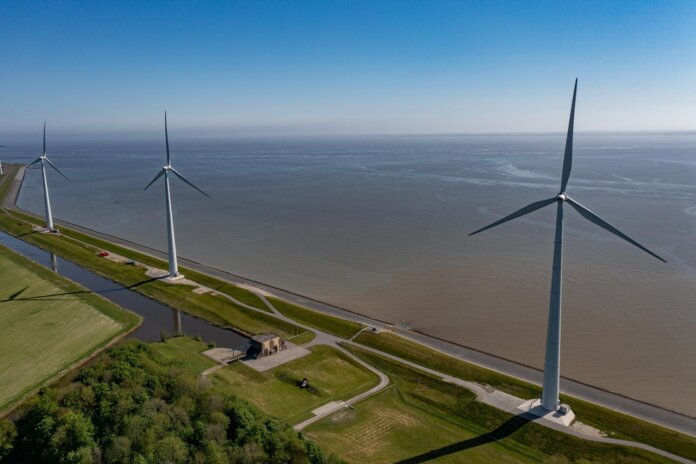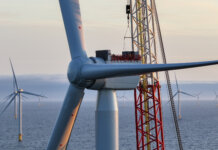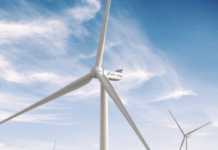For the first time, wind turbines are now running on a sea dike. In Eemshaven, within the Dutch province of Groningen, RWE has erected three wind power plants with an installed capacity of 7.5 MW.
In order to safely install the individual components in this particular location, with limited space around it, RWE relied on some innovative installation methods. For the installation of the upper turbine components, for example, a special climbing crane was used, which climbed upwards by inserting individual segments as construction progressed.
“Our three wind turbines on top of a sea dike are a world first,” says Katja Wünschel, CEO of onshore wind and solar Europe and Australia at RWE Renewables. “The Oostpolderdijk project illustrates the potential for dikes to have an additional role. In taking this action, we are also conscious of our particular responsibility to uphold the integrity and safety of the dike, which is our highest priority. With innovative projects like these, we are creating new options for the expansion of renewable energies.”
In addition, the turbines were erected on so-called CSM (cutter soil mixing) panels. In this process, the existing soil is strengthened by mixing it with concrete and covered with a layer of sand on which the foundations are then built. In this way, the wind turbines are not directly connected to the subsoil and can safely move with it if the dike settles.
“This world first and all the installation challenges are paying off,” adds Wünschel. “The wind conditions in this exposed location are excellent. The three turbines will generate sufficient green power to supply up to 7000 Dutch households annually. And we have gained valuable insights from completing this project, which will enable us to erect wind farms on dikes in other locations too. My particular thanks go to the Noorderzijlvest Water Board and the consent authorities involved for their many years of constructive cooperation.”
Over the past few years, RWE and the owner of the dike, the Noorderzijlvest Water Board, meticulously analyzed the installation process, with a view to dike safety and the potential environmental impacts of the project, and incorporated this into a technically complex design. The most important aspect of the project development process was protection of the dike to ensure its flood-water prevention function was not impaired in any way.
The electricity from the wind farm has already been marketed: In February, RWE signed a power purchase agreement with ASML, a provider of lithographic systems for the semiconductor industry, on the supply of green power, which will be generated at this wind farm in Oostpolderdijk amongst other places.




